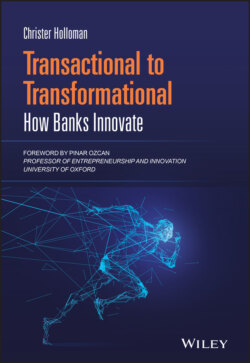Читать книгу Transactional to Transformational - Christer Holloman - Страница 18
Solution
Оглавление‘We invest in fintechs who have the potential to really help deliver improvements to the business and service to customers. The more core these solutions sit in our architecture and customer service proposition, the more we consider taking equity stakes.’
Zak Mian, Group Transformation Director
A working group was formed between the central innovation and corporate development teams in order to design solutions for the identified gaps across the end‐to‐end partnering journey: from idea to execution. The team began by developing a framework for enhancing fintech partnering along key stages of the process.
Their initial steps were to create a shared definition of the key stages in the partnering process. Whilst they identified differing numbers of steps in use across industries, the overall process was similar. They opted for a five‐stage process, leveraging definitions already in use in one area of the bank. All those definitions relate to partnering opportunities for a specified business need:
Identify. A long list of relevant fintechs has been identified.
Assess. A selection has been made for a preferred potential partner (typically an initial desktop exercise to form a shortlist and then more detailed interaction with the remaining parties).
Engage. Initial experimentation with the potential partner to test the target partnership solution is being developed or is underway.
Advance. Deployment of the partnership is planned at scale, including a final partnership structure.
Breaking down these processes into these stages enabled them both to build up a cross‐group pipeline view and would provide a way to structure potential solutions to the gaps they had identified.
As with many innovation processes, they understood that for each successful partnership reaching the advance stages, many more would need to have been explored and ruled out earlier in the process. Therefore, it was critical that they sourced adequate opportunities from across the bank.
The first step would be to create business‐sponsored innovation working groups for their main transformation lines: Retail, Insurance, Commercial and Enterprise (RICE). Each working group would consist of product‐level representation, typically from business development, strategy or innovation roles. The working group would become a route through which to disseminate best‐practice in terms of fintech scanning, selection and partnering. In addition, additional tooling would be made available to the groups to enable them to execute these activities. For example, access to a central fintech hub was distributed as a way to identify and monitor relevant fintechs across the group, while also providing divisional and group‐level data to support decision‐making. The working group approach would also provide a way to identify gaps in activity relative to a designated baseline.
Another part of the solution would be to develop a collective understanding of the characteristics of a robust innovation partnership. This would centre on being able to prioritise business needs for which a fintech partner solution had the potential to add the most value relative to a build solution. This would begin by leveraging their initial analysis, but would quickly become enhanced by evidence and experience. At the same time, before selection opportunities to prioritise, they would also need to consider the expected complexity of pursuing them. The netting out of these two characteristics would help to determine which opportunities would be prioritised.
Importantly, they recognised that the complexity of partnering was not a fixed thing. Rather it was something they could aim to improve over time and thereby potentially increase their opportunity space. As such, they would continue to investigate technological and non‐technological opportunities to make partnerships easier to deliver, whilst still achieving appropriate levels of safety and security.
At the advance end of the process, they would utilise their pathfinder opportunity alongside non‐fintech partnership experience to inform their approach to partnership structuring. A key element of this was consideration of equity investments. Where there was an opportunity to invest, they decided on two core principles that would need to be met. Firstly, they would only consider investing in companies with whom they expected to form a commercial agreement or had done so already. Secondly, there would need to be a very clearly defined strategic benefit of taking equity, relative to what was achievable through a commercial contract. Their initial appetite was also focused on minority investment stakes only, due to the additional consolidation considerations typically associated with larger positions. It was at this point in the process that they would utilise their pathfinder opportunity to begin building some of the specific capabilities required for fintech investing.
In order to oversee the implementation of all these steps and to provide additional senior stakeholder sponsorship, they would create a Corporate Venture Panel (CVP). These sponsors included a senior colleague from each of the RICE areas, along with senior colleagues from enabling areas such as Group Legal and the Chief Technology Office. The panel would initially meet on a quarterly basis to oversee the pan‐Group activity, review partnering decisioning and consider investment rationale.
